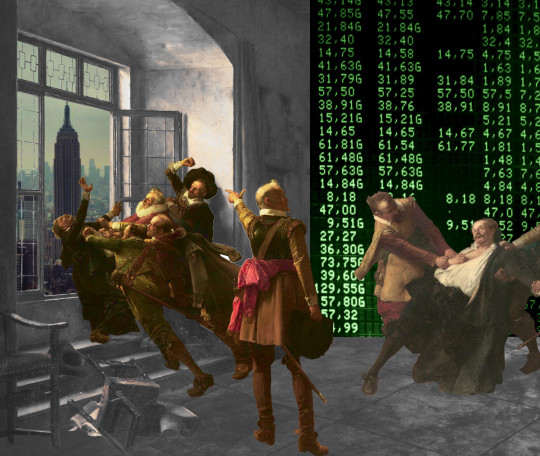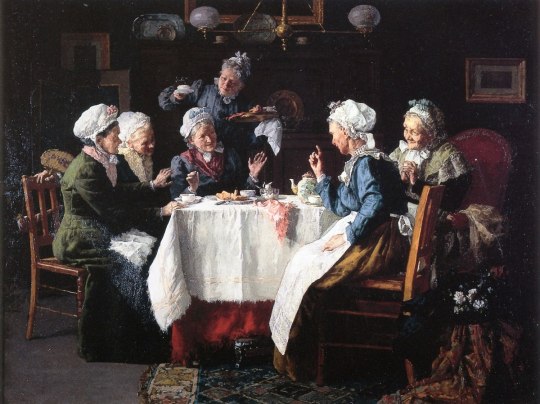#American Privateers
Text

America, the "most noted Salem privateer" from A History of American Privateers by Edgar Stanton Maclay (1899).
The America arrived at Salem from her last venture, April 10, 1815, after a cruise of one hundred and thirty-four days. In the course of the war she netted her owners six hundred thousand dollars. On the close of hostilities she was tied up at Crowninshield's wharf, where she remained a number of years. In June, 1831, she was sold at auction and broken up.
Even though there is a 2014 article in Naval History Magazine arguing that privateers played an important role in the War of 1812, I am thinking about what Alfred Lorrain wrote. He titled a chapter in his autobiography SECOND MATE—PRIVATEERING which you might think at first glance means he was on a privateer, but it's actually all about how much he hates privateers and thinks they're cruel and unethical. A History of American Privateers also mentions the huge sums brought in by privateers owned by James DeWolf in a chapter dedicated to Rhode Island. I am suspicious of a known trafficker of enslaved people in the privateering business, especially since DeWolf's ships were always off the coast of Africa in the War of 1812.
#War of 1812 Wednesday#war of 1812#age of sail#privateer#privateering#naval history#military history#alfred lorrain#us history#american privateers#rhode island#james dewolf#shhh it's still wednesday in my time zone
10 notes
·
View notes
Text

(Source)
After the plane ride, he went on to praise the organization behind the project. Trump has since lied — saying he "had no idea" about anything to do with the project..
#destiel#donald trump#project 2025#kevin roberts#heritage foundation#private jet#us politics#american politics#castiel#dean winchester#breaking news
577 notes
·
View notes
Text
How to shatter the class solidarity of the ruling class

I'm touring my new, nationally bestselling novel The Bezzle! Catch me WEDNESDAY (Apr 11) at UCLA, then Chicago (Apr 17), Torino (Apr 21) Marin County (Apr 27), Winnipeg (May 2), Calgary (May 3), Vancouver (May 4), and beyond!

Audre Lorde counsels us that "The Master's Tools Will Never Dismantle the Master's House," while MLK said "the law cannot make a man love me, but it can restrain him from lynching me." Somewhere between replacing the system and using the system lies a pragmatic – if easily derailed – course.
Lorde is telling us that a rotten system can't be redeemed by using its own chosen reform mechanisms. King's telling us that unless we live, we can't fight – so anything within the system that makes it easier for your comrades to fight on can hasten the end of the system.
Take the problems of journalism. One old model of journalism funding involved wealthy newspaper families profiting handsomely by selling local appliance store owners the right to reach the townspeople who wanted to read sports-scores. These families expressed their patrician love of their town by peeling off some of those profits to pay reporters to sit through municipal council meetings or even travel overseas and get shot at.
In retrospect, this wasn't ever going to be a stable arrangement. It relied on both the inconstant generosity of newspaper barons and the absence of a superior way to show washing-machine ads to people who might want to buy washing machines. Neither of these were good long-term bets. Not only were newspaper barons easily distracted from their sense of patrician duty (especially when their own power was called into question), but there were lots of better ways to connect buyers and sellers lurking in potentia.
All of this was grossly exacerbated by tech monopolies. Tech barons aren't smarter or more evil than newspaper barons, but they have better tools, and so now they take 51 cents out of every ad dollar and 30 cents out of ever subscriber dollar and they refuse to deliver the news to users who explicitly requested it, unless the news company pays them a bribe to "boost" their posts:
https://www.eff.org/deeplinks/2023/04/saving-news-big-tech
The news is important, and people sign up to make, digest, and discuss the news for many non-economic reasons, which means that the news continues to struggle along, despite all the economic impediments and the vulture capitalists and tech monopolists who fight one another for which one will get to take the biggest bite out of the press. We've got outstanding nonprofit news outlets like Propublica, journalist-owned outlets like 404 Media, and crowdfunded reporters like Molly White (and winner-take-all outlets like the New York Times).
But as Hamilton Nolan points out, "that pot of money…is only large enough to produce a small fraction of the journalism that was being produced in past generations":
https://www.hamiltonnolan.com/p/what-will-replace-advertising-revenue
For Nolan, "public funding of journalism is the only way to fix this…If we accept that journalism is not just a business or a form of entertainment but a public good, then funding it with public money makes perfect sense":
https://www.hamiltonnolan.com/p/public-funding-of-journalism-is-the
Having grown up in Canada – under the CBC – and then lived for a quarter of my life in the UK – under the BBC – I am very enthusiastic about Nolan's solution. There are obvious problems with publicly funded journalism, like the politicization of news coverage:
https://www.theguardian.com/media/2023/jan/24/panel-approving-richard-sharp-as-bbc-chair-included-tory-party-donor
And the transformation of the funding into a cheap political football:
https://www.cbc.ca/news/politics/poilievre-defund-cbc-change-law-1.6810434
But the worst version of those problems is still better than the best version of the private-equity-funded model of news production.
But Nolan notes the emergence of a new form of hedge fund news, one that is awfully promising, and also terribly fraught: Hunterbrook Media, an investigative news outlet owned by short-sellers who pay journalists to research and publish damning reports on companies they hold a short position on:
https://hntrbrk.com/
For those of you who are blissfully distant from the machinations of the financial markets, "short selling" is a wager that a company's stock price will go down. A gambler who takes a short position on a company's stock can make a lot of money if the company stumbles or fails altogether (but if the company does well, the short can suffer literally unlimited losses).
Shorts have historically paid analysts to dig into companies and uncover the sins hidden on their balance-sheets, but as Matt Levine points out, journalists work for a fraction of the price of analysts and are at least as good at uncovering dirt as MBAs are:
https://www.bloomberg.com/opinion/articles/2024-04-02/a-hedge-fund-that-s-also-a-newspaper
What's more, shorts who discover dirt on a company still need to convince journalists to publicize their findings and trigger the sell-off that makes their short position pay off. Shorts who own a muckraking journalistic operation can skip this step: they are the journalists.
There's a way in which this is sheer genius. Well-funded shorts who don't care about the news per se can still be motivated into funding freely available, high-quality investigative journalism about corporate malfeasance (notoriously, one of the least attractive forms of journalism for advertisers). They can pay journalists top dollar – even bid against each other for the most talented journalists – and supply them with all the tools they need to ply their trade. A short won't ever try the kind of bullshit the owners of Vice pulled, paying themselves millions while their journalists lose access to Lexisnexis or the PACER database:
https://pluralistic.net/2024/02/24/anti-posse/#when-you-absolutely-positively-dont-give-a-solitary-single-fuck
The shorts whose journalists are best equipped stand to make the most money. What's not to like?
Well, the issue here is whether the ruling class's sense of solidarity is stronger than its greed. The wealthy have historically oscillated between real solidarity (think of the ultrawealthy lobbying to support bipartisan votes for tax cuts and bailouts) and "war of all against all" (as when wealthy colonizers dragged their countries into WWI after the supply of countries to steal ran out).
After all, the reason companies engage in the scams that shorts reveal is that they are profitable. "Behind every great fortune is a great crime," and that's just great. You don't win the game when you get into heaven, you win it when you get into the Forbes Rich List.
Take monopolies: investors like the upside of backing an upstart company that gobbles up some staid industry's margins – Amazon vs publishing, say, or Uber vs taxis. But while there's a lot of upside in that move, there's also a lot of risk: most companies that set out to "disrupt" an industry sink, taking their investors' capital down with them.
Contrast that with monopolies: backing a company that merges with its rivals and buys every small company that might someday grow large is a sure thing. Shriven of "wasteful competition," a company can lower quality, raise prices, capture its regulators, screw its workers and suppliers and laugh all the way to Davos. A big enough company can ignore the complaints of those workers, customers and regulators. They're not just too big to fail. They're not just too big to jail. They're too big to care:
https://pluralistic.net/2024/04/04/teach-me-how-to-shruggie/#kagi
Would-be monopolists are stuck in a high-stakes Prisoner's Dilemma. If they cooperate, they can screw over everyone else and get unimaginably rich. But if one party defects, they can raid the monopolist's margins, short its stock, and snitch to its regulators.
It's true that there's a clear incentive for hedge-fund managers to fund investigative journalism into other hedge-fund managers' portfolio companies. But it would be even more profitable for both of those hedgies to join forces and collude to screw the rest of us over. So long as they mistrust each other, we might see some benefit from that adversarial relationship. But the point of the 0.1% is that there aren't very many of them. The Aspen Institute can rent a hall that will hold an appreciable fraction of that crowd. They buy their private jets and bespoke suits and powdered rhino horn from the same exclusive sellers. Their kids go to the same elite schools. They know each other, and they have every opportunity to get drunk together at a charity ball or a society wedding and cook up a plan to join forces.
This is the problem at the core of "mechanism design" grounded in "rational self-interest." If you try to create a system where people do the right thing because they're selfish assholes, you normalize being a selfish asshole. Eventually, the selfish assholes form a cozy little League of Selfish Assholes and turn on the rest of us.
Appeals to morality don't work on unethical people, but appeals to immorality crowds out ethics. Take the ancient split between "free software" (software that is designed to maximize the freedom of the people who use it) and "open source software" (identical to free software, but promoted as a better way to make robust code through transparency and peer review).
Over the years, open source – an appeal to your own selfish need for better code – triumphed over free software, and its appeal to the ethics of a world of "software freedom." But it turns out that while the difference between "open" and "free" was once mere semantics, it's fully possible to decouple the two. Today, we have lots of "open source": you can see the code that Google, Microsoft, Apple and Facebook uses, and even contribute your labor to it for free. But you can't actually decide how the software you write works, because it all takes a loop through Google, Microsoft, Apple or Facebook's servers, and only those trillion-dollar tech monopolists have the software freedom to determine how those servers work:
https://pluralistic.net/2020/05/04/which-side-are-you-on/#tivoization-and-beyond
That's ruling class solidarity. The Big Tech firms have hidden a myriad of sins beneath their bafflegab and balance-sheets. These (as yet) undiscovered scams constitute a "bezzle," which JK Galbraith defined as "the magic interval when a confidence trickster knows he has the money he has appropriated but the victim does not yet understand that he has lost it."
The purpose of Hunterbrook is to discover and destroy bezzles, hastening the moment of realization that the wealth we all feel in a world of seemingly orderly technology is really an illusion. Hunterbrook certainly has its pick of bezzles to choose from, because we are living in a Golden Age of the Bezzle.
Which is why I titled my new novel The Bezzle. It's a tale of high-tech finance scams, starring my two-fisted forensic accountant Marty Hench, and in this volume, Hench is called upon to unwind a predatory prison-tech scam that victimizes the most vulnerable people in America – our army of prisoners – and their families:
https://us.macmillan.com/books/9781250865878/thebezzle
The scheme I fictionalize in The Bezzle is very real. Prison-tech monopolists like Securus and Viapath bribe prison officials to abolish calls, in-person visits, mail and parcels, then they supply prisoners with "free" tablets where they pay hugely inflated rates to receive mail, speak to their families, and access ebooks, distance education and other electronic media:
https://pluralistic.net/2024/04/02/captive-customers/#guillotine-watch
But a group of activists have cornered these high-tech predators, run them to ground and driven them to the brink of extinction, and they've done it using "the master's tools" – with appeals to regulators and the finance sector itself.
Writing for The Appeal, Dana Floberg and Morgan Duckett describe the campaign they waged with Worth Rises to bankrupt the prison-tech sector:
https://theappeal.org/securus-bankruptcy-prison-telecom-industry/
Here's the headline figure: Securus is $1.8 billion in debt, and it has eight months to find a financier or it will go bust. What's more, all the creditors it might reasonably approach have rejected its overtures, and its bonds have been downrated to junk status. It's a dead duck.
Even better is how this happened. Securus's debt problems started with its acquisition, a leveraged buyout by Platinum Equity, who borrowed heavily against the firm and then looted it with bogus "management fees" that meant that the debt continued to grow, despite Securus's $700m in annual revenue from America's prisoners. Platinum was just the last in a long line of PE companies that loaded up Securus with debt and merged it with its competitors, who were also mortgaged to make profits for other private equity funds.
For years, Securus and Platinum were able to service their debt and roll it over when it came due. But after Worth Rises got NYC to pass a law making jail calls free, creditors started to back away from Securus. It's one thing for Securus to charge $18 for a local call from a prison when it's splitting the money with the city jail system. But when that $18 needs to be paid by the city, they're going to demand much lower prices. To make things worse for Securus, prison reformers got similar laws passed in San Francisco and in Connecticut.
Securus tried to outrun its problems by gobbling up one of its major rivals, Icsolutions, but Worth Rises and its coalition convinced regulators at the FCC to block the merger. Securus abandoned the deal:
https://worthrises.org/blogpost/securusmerger
Then, Worth Rises targeted Platinum Equity, going after the pension funds and other investors whose capital Platinum used to keep Securus going. The massive negative press campaign led to eight-figure disinvestments:
https://www.latimes.com/business/story/2019-09-05/la-fi-tom-gores-securus-prison-phone-mass-incarceration
Now, Securus's debt became "distressed," trading at $0.47 on the dollar. A brief, covid-fueled reprieve gave Securus a temporary lifeline, as prisoners' families were barred from in-person visits and had to pay Securus's rates to talk to their incarcerated loved ones. But after lockdown, Securus's troubles picked up right where they left off.
They targeted Platinum's founder, Tom Gores, who papered over his bloody fortune by styling himself as a philanthropist and sports-team owner. After a campaign by Worth Rises and Color of Change, Gores was kicked off the Los Angeles County Museum of Art board. When Gores tried to flip Securus to a SPAC – the same scam Trump pulled with Truth Social – the negative publicity about Securus's unsound morals and financials killed the deal:
https://twitter.com/WorthRises/status/1578034977828384769
Meanwhile, more states and cities are making prisoners' communications free, further worsening Securus's finances:
https://pluralistic.net/2024/02/14/minnesota-nice/#shitty-technology-adoption-curve
Congress passed the Martha Wright-Reed Just and Reasonable Communications Act, giving the FCC the power to regulate the price of federal prisoners' communications. Securus's debt prices tumbled further:
https://www.govtrack.us/congress/bills/117/s1541
Securus's debts were coming due: it owes $1.3b in 2024, and hundreds of millions more in 2025. Platinum has promised a $400m cash infusion, but that didn't sway S&P Global, a bond-rating agency that re-rated Securus's bonds as "CCC" (compare with "AAA"). Moody's concurred. Now, Securus is stuck selling junk-bonds:
https://www.govtrack.us/congress/bills/117/s1541
The company's creditors have given Securus an eight-month runway to find a new lender before they force it into bankruptcy. The company's debt is trading at $0.08 on the dollar.
Securus's major competitor is Viapath (prison tech is a duopoly). Viapath is also debt-burdened and desperate, thanks to a parallel campaign by Worth Rises, and has tried all of Securus's tricks, and failed:
https://pestakeholder.org/news/american-securities-fails-to-sell-prison-telecom-company-viapath/
Viapath's debts are due next year, and if Securus tanks, no one in their right mind will give Viapath a dime. They're the walking dead.
Worth Rise's brilliant guerrilla warfare against prison-tech and its private equity backers are a master class in using the master's tools to dismantle the master's house. The finance sector isn't a friend of justice or working people, but sometimes it can be used tactically against financialization itself. To paraphrase MLK, "finance can't make a corporation love you, but it can stop a corporation from destroying you."
Yes, the ruling class finds solidarity at the most unexpected moments, and yes, it's easy for appeals to greed to institutionalize greediness. But whether it's funding unbezzling journalism through short selling, or freeing prisons by brandishing their cooked balance-sheets in the faces of bond-rating agencies, there's a lot of good we can do on the way to dismantling the system.

If you'd like an essay-formatted version of this post to read or share, here's a link to it on pluralistic.net, my surveillance-free, ad-free, tracker-free blog:
https://pluralistic.net/2024/04/08/money-talks/#bullshit-walks

Image:
KMJ (modified)
https://commons.wikimedia.org/wiki/File:Boerse_01_KMJ.jpg
CC BY-SA 3.0
https://creativecommons.org/licenses/by-sa/3.0/deed.en
#pluralistic#shorts#short sellers#news#private equity#private prisons#securus#prison profiteers#the bezzle#anything that cant go on forever eventually stop#steins law#hamilton nolan#Platinum Equity#American Securities#viapath#global tellink#debt#jpay#worth rises#insurance#spacs#fcc#bond rating#moodys#the appeal#saving the news from big tech#hunterbrook media#journalism
804 notes
·
View notes
Text
okay because i am DEATHLY curious about this, please select from the options below. reblog with your country of origin as well please.
ETA BECAUSE PEOPLE ARE GETTING SNARKY: i am asking it this specific way with these specific poll options (american vs non-american) because it's my understanding and experience that most US state public schools actively suppress any teaching of labor history in any concrete way to the point of editing textbooks. i'm not trying to be an american exclusionist here or say that there weren't non-american labor movements. i'm saying that as a historian with degrees i have noticed that there is a very different attitude towards teaching labor history in the united states than there is in other countries. for fuck's sake.
#DEEPLY curious about this#labor history#history#poll#because i feel like a lot of americans don't actually realize that public schools (and private schools) teach JACK SHIT about labor history#the number of people i have met who have no idea what the battle of blair mountain is#anyway#shut up alix no one cares#labor rights#workers rights#sometimes alix goes viral
1K notes
·
View notes
Text

The Apparition of the Grail to Percival, Pinckney Marcius-Simons, ca. 1904
#art#art history#Pinckney Marcius-Simons#mythological painting#Arthurian mythology#Arthurian legend#Arthuriana#Grail Cycle#Holy Grail#Sir Percival#illustration#Richard Wagner#Parsifal#Symbolism#Symbolist art#American art#20th century art#oil on panel#private collection
801 notes
·
View notes
Text

Behold.. Idaho becomes the first to require ID.. for the PUBLIC LIBRARY. Knowledge and Thinking is the enemy.
#Behold.. Idaho becomes the first to require ID.. for the PUBLIC LIBRARY. Knowledge and Thinking is the enemy.#duncan idaho#idaho news#my own private idaho#idahobit#idaho#identification#public libraries#public librarian#public library#law#morals#ethics#privacy#invasion of privacy#usa news#usa is a terrorist state#usa politics#usa#american indian#american#america#ausgov#politas#auspol#tasgov#taspol#australia#fuck neoliberals#neoliberal capitalism
242 notes
·
View notes
Text


this drawing made krita crash 8 times btw
#mine.art#roshambogames#was originally gonna have ro do a similar pose to mapicc so theyd cross swords but i uh. forgor.#edit: the correct version didnt save for some reason??? so reuploaded#edit 2: just noticed a small error#i really need to post my art privately beefore making them public or something cause i somehow only see errors after uploading#mapicc redesign is based on american leopard hounds#zam#mape
222 notes
·
View notes
Photo


by Micell A.
#art#print#illustration#artist#micell a.#beautiful#hat#fashion#style#mysterious#smart#intelligent#calypso#woman power#the best#african-american#private detective
460 notes
·
View notes
Photo

Mia Bergeron
Lovers
#mia bergeron#figurative art#animal paintings#nocturne#loose brushwork#contemporary art#women artists#american artist#private collection
2K notes
·
View notes
Text

“American Woman”, 2013 by Norman Engel
#contemporary art#contemporary painting#Norman Engel#Texas artist#southwest art#western art#contemporary western art#native american#american indian#folk art#folk art painting#naive art#primitivism#outsider art#modern art#painting#acrylic on canvas#sold#private collection
61 notes
·
View notes
Text

Louis Moeller (1855-1930)
"Tea Party" (1905)
Oil on canvas
Currently in a private collection
#paintings#art#artwork#genre painting#genre scene#louis moeller#oil on canvas#fine art#private collection#american artist#tea#interior#female portrait#portrait of a woman#clothing#clothes#early 1900s#early 20th century#a queue work of art
93 notes
·
View notes
Text
#public schools#private schools#funding#budget#budgets#budgeting#education#America#american education system#education system#school#kids#children#youth#educators#government funding#local government#state government#federal government#education is important#fund education#reality#politics#democrats#republicans#independent#capitalism#political games#kentucky#andy beshear
60 notes
·
View notes
Text
By Jake Johnson
Common Dreams
June 25, 2024
"Instead of siphoning money and increasing tax breaks to subsidize private education, we have a responsibility to ensure all students have access to quality K-12 education."
Sen. Bernie Sanders released a report Tuesday detailing how right-wing billionaires are bankrolling coordinated efforts to privatize U.S. public education by promoting voucher programs that siphon critical funding away from already-underresourced public schools.
The report notes that last year, the American Federation for Children (AFC)—an organization funded by former Trump Education Secretary Betsy DeVos—"ousted state lawmakers in Iowa and Arkansas who resisted proposals to subsidize private education in states and passed expansive private school vouchers."
Aided by millions of dollars in funding from DeVos and her husband, "AFC's political affiliates and allies spent $9 million to win 277 out of 368 races to remove at least 40 incumbent lawmakers," the report adds.
The DeVos family is hardly alone in using its wealth to undercut U.S. public education. The Bradley Foundation, which has been knee-deep in efforts to privatize education in Wisconsin and across the country, spent $7.5 million in 2022 "to fund 34 state affiliates of the State Policy Network to push conservative policy agendas, including privatizing education, and $8.3 million to building a youth movement to 'win the American Culture War.'"
"The Koch-sponsored group, American Encore, has funneled substantial amounts into state governor races and ballot initiatives around the country, including more than $1.4 million to elect Arizona's former governor Doug Ducey in 2014 (who led the efforts to create the nation's first universal private school voucher)," the report adds.
"For too long, there's been a coordinated effort to sabotage our public schools and privatize our education system. Unacceptable."
The analysis also names billionaires Jess Yass of Susquehanna International Group, Richard Uihlein of Uline, and Bernard Marcus of Home Depot, all of whom have recently donated to the School Freedom Fund—a PAC that supports voucher programs and shuttering the U.S. Education Department.
School voucher programs disproportionately benefit wealthy families, analyses have shown, while undercutting the goal of serving all students within a community.
"Over the past decade, there has been a coordinated effort on the part of right-wing billionaires to undermine, dismantle, and sabotage our nation's public schools and to privatize our education system," Sanders (I-Vt.), chairman of the Senate Health, Education, Labor, and Pensions (HELP) Committee, said in a statement. " That is absolutely unacceptable."
"We can no longer tolerate billionaires and multinational corporations receiving massive tax breaks and subsidies while children in America are forced to go to understaffed, underresourced, and underfunded public schools," Sanders continued. "On this 70th anniversary year of Brown v. Board of Education, let us recommit to creating an education system that works for all of our people, not just the wealthy few."

The new report, authored by the Senate HELP Committee's majority staff, comes days after Sanders presided over a hearing at which a pair of public school teachers decried the low educator pay and lack of resources plaguing schools across the U.S. and threatening the foundations of the country's public education system.
The committee's report shows that while most states have chronically underfunded their public schools, spending on voucher programs that subsidize private schools with taxpayer dollars has surged across the country. Between 2008 and 2019, according to a recent analysis cited in the report, Florida ramped up spending on voucher programs by 313% while "decreasing per-pupil funding of public schooling by 12%."
"The expansion of private school voucher programs forces very real tradeoffs. Money spent on private school vouchers could instead be used to hire teachers, raise wages, hire school counselors, and invest in high-quality academics for students," reads the new report, which estimates that "Arizona could hire 15,730 more public K-12 teachers with the money it is instead spending on private school vouchers."
The report calls on Congress to help reverse the trend of billionaire-backed school privatization by investing more in public education—including early childhood education and community schools—and by passing Sanders' legislation to set the pay floor for U.S. public school teachers at $60,000 a year.
The report also recommends passage of the College for All Act, a Sanders-led bill that would make public colleges and universities tuition-free for students from households making less than $250,000 a year.
"As the richest country in history, the United States should have the best education system in the world," Sanders' report reads. "Our public education system is not perfect—it is underfunded and racially and socioeconomically segregated. Our educators are not respected or paid nearly what they deserve."
"Massive tax breaks to the wealthiest people and largest corporations are being prioritized over opportunities to progressively raise revenue to support social services and public education," the report continues. "Instead of siphoning money and increasing tax breaks to subsidize private education, we have a responsibility to ensure all students have access to quality K-12 education. This requires adequate and equitable funding and addressing structural challenges in our public schools."
#bernie sanders#school vouchers#public schools#public education#private school#school freedom fund#bradley foundation#american encore#betsy devos#right wing politics#right wing extremism
47 notes
·
View notes
Text

Chair Car, Edward Hopper, 1965
#art#art history#Edward Hopper#interior#Realism#Realist art#American Realism#New Realism#American art#modern art#20th century art#oil on canvas#private collection
295 notes
·
View notes
Text
#american film institute#afi#movie polls#epic film#epic movie#titanic 1997#lawrence of arabia#ben hur#spartacus#gone with the wind#reds#the ten commandments#saving private ryan#all quiet on the western front#schindler's list#old movies#old films#vintage movies#old hollywood#classic film#classic cinema#ben hur 1959#titanic
83 notes
·
View notes
Text

Lake George Reflection (1921–1922)
🎨 Georgia O'Keeffe
🏛️ Private Collection
📍 Somewhere
Painted circa 1921-22, Georgia O’Keeffe’s Lake George Reflection embodies the contradictions inherent in the artist’s best work which came to define her career and cement her legacy as one of the most enduring and intriguing figures in 20th-century American Art. Lake George Reflection, the most ambitious in scale of her works from the 1920s, is a meditation on the sublime, building upon the tradition of the 19th century Hudson River School artists who sought to capture the drama and beauty of the unspoiled landscape surrounding Lake George. Presented alternatively as both a vertical and horizontal composition, the work is an expression of the artist’s experimental thought process as she considered what it meant to be representational in an age of burgeoning abstraction in American Art. Horizontally, the painting exemplifies the boldly colorful landscapes which have become a hallmark of O’Keeffe’s career, foreshadowing the abstracted paintings of the New Mexico hills from her later years. When viewed vertically, as Lake George Reflection was first exhibited in 1923 at the Anderson Galleries, the infinite horizon shifts to a powerful vertical thrust, with the formerly symmetrical reflections of the landscape morphing into the interior folds of a magnified flower or echoing the bold and daring heights of a New York City skyscraper. This ambiguity of orientation results in a painting that is at once highly representational and wholly abstract, carefully constructed and malleable, and which defines the subtle power of O’Keeffe’s most dramatic and admired works. O’Keeffe signified the importance of certain works by including a hand-drawn star on the reverse or backing board; she noted this distinction on the verso of Lake George Reflection.
On June 10th, 1918, Georgia O’Keeffe moved to New York City. That August, she visited Lake George in the Hudson River Valley with Alfred Stieglitz, the influential photographer and art dealer twenty years her senior whom she would marry in 1924. On this first extended trip to the area, the Stieglitz family’s 36-acre retreat provided a welcome respite from the city, and one that afforded creative inspiration and freedom. “Stieglitz, like many urbanites then and now, also had a rural base, at Lake George in upstate New York, and every year he joined other members of the large family at his mother's home there. In August 1918, he was accompanied by O'Keeffe, who was warmly received by the mater familias and the sundry siblings, in-laws, and offspring of the Stieglitz tribe." (Georgia O'Keeffe, New York, 1991, p. 39) Over the next decade, O’Keeffe and Stieglitz frequently visited Lake George, spending most of every summer and early fall on the family compound, first at ‘Oaklawn’ and later at ‘The Hill.’ The landscape and its environs seemed to stimulate her creatively and she often referred to it as ‘perfect.’ The flora and fauna, and the relationship she developed with botanist Donald Davidson, a Stieglitz family cousin, provided veritable fertile ground for artistic discovery.
Just as Lake George exhilarated O’Keeffe, it also ushered in a period of creativity and artistic exploration for Stieglitz, allowing him to view the landscape through new eyes. “Although in earlier summers he had all but overlooked the landscape at his family’s home in Lake George, New York, he now began to photograph it, stimulated both by O’Keeffe’s infectious enthusiasm for the natural world and her own paintings of the area. Citing her ability to put ‘her experiences in paint,’ Stieglitz wrote that he too endeavored to ‘put his feelings into form’ in his photographs of the trees, barns, and buildings, as well as the landscape and clouds that surrounded him.” (B.B. Lynes, Georgia O’Keeffe, 2001, pp. 26-27) Whether sparked by lively competition or simply that O’Keeffe’s admiration of the landscape invigorated Stieglitz, both artists created some of their most bold, dynamic and experimental imagery during this time. Barbara Buhler Lynes notes, “Stieglitz’s investigation of equivalence began in the early 1920s at Lake George. O’Keeffe was involved with a parallel effort, working with color as Stieglitz had worked with light. Both his photograph and her painting suggest grand panoramas and infinite distances, while at the same time that vastness is overridden by patterns of flat, undulating shapes.” (Georgia O’Keeffe, 2001, p. 38)
In addition to the myriad of visual delights that the great view from the property afforded, it would not have been lost on O’Keeffe that she was on hallowed artistic ground. “As any visitor to Lake George, then or now, she would have been more aware of its role as a popular tourist destination reaching back to the early 1800s. In the wake of the French and Indian War (1754-63) and the American Revolution (1775-83), it captivated the hearts and minds of Americans, who were increasingly nostalgic about their history. The 1826 publication of James Fenimore Cooper’s The Last of the Mohicans sealed Lake George’s fate as an American icon.” (Modern Nature: Georgia O’Keeffe and Lake George, p. 23). Many 19th century predecessors captured the autumnal foliage, verdant hills and crystalline lakes, putting forth a vision of the landscape as untouched and unspoiled. These Hudson River School depictions, often dramatized with sunrises and sunsets, emphasized the sublime in nature, a concept that would have no doubt interested O’Keeffe. “Over the past two centuries, the concept of the sublime—with its immediate sensation of awe inspiring infinite space and evocative color and light directly internalized to moments experienced in our own lives—has been substantially redefined by a small number of artists, writers, and critics, for whom it has become a vital source of spiritual values at times of increased secularism.” (Georgia O’Keeffe: Visions of the Sublime, 2004, London, p. vii)
Seen as a landscape, Lake George Reflection is a meditation on the awesomeness of the open countryside of upstate New York found only a short distance from the hectic metropolis. Incorporating the groundbreaking experimentations from her early career, the rolling hills and water are depicted in the undulating forms so prevalent in O’Keeffe’s early abstractions of the previous decade. Similarly, the bulbous forms that line the foreground recall her abstract ‘Special’ series, also executed at Lake George a few years earlier. Taking these elements one step further, all is reflected, creating a virtual mirror image bifurcated by a dramatic horizontal cross-section. With its monumental scale, the resulting image echoes the images of sublimity in 19th-century art, which captured the grandeur of the landscape, an untouched splendor and a vastness seemingly born from the imagination. Lake George Reflection similarly suggests a landscape of infinite scale, confined by but not limited to the expanse of the canvas.
For the exhibition at Anderson Galleries in 1923, the first time Lake George Reflection was exhibited, O’Keeffe dictated that the painting be hung vertically. While the title suggests a certain formal interpretation to her work, the adjustment of orientation altered the viewer’s understanding of it, particularly when viewed in context with other work from the period. The change solely in orientation of Lake George Reflection, not to the painting, forces the viewer to understand the forms in a different manner. Marjorie Balge-Crozier describes this phenomenon in O’Keeffe’s works from this period, writing, “Manipulation of scale, depictions of fragments, precise lines and blurred edges, bold colors—all of these devices are used to create works that are emotional equivalents for her experiences. These are devices that can also elicit feelings of uncertainty, awe, and even terror in the spectator, whether one is looking at a close-up view of a flower or the splitting darkness of the Black Place. Paintings that are extremely minimal can appear at first as objects for calming meditation, then dissolve into uneasy questions of identity, with hills resembling body parts. In the end, the spectator is left with an equivalent sublime experience.” (Georgia O’Keeffe: Visions of the Sublime, p. 103)
Particularly when understood vertically, Lake George Reflection encourages anthropomorphic comparisons. Sharyn Udall explains, “Some of her landscapes do contain forms that—perhaps without any conscious intention on her part—insist on some relationship to the body. At Lake George in 1919 O’Keeffe produced several paintings of bifurcated glowing forms that begin as landscape but become increasingly abstract.” (Georgia O’Keeffe: Visions of the Sublime, p. 118) As a vertical work, the painting most closely relates to her magnified flower imagery, which she was simultaneously exploring. In works such as Flower Abstraction (1924, Whitney Museum of American Art), undulating lines and soft coral tones are quite clearly evocative of the delicate petals of a flower but the cragged vertical white line serves to bisect the image, echoing the compositional format of Lake George Reflection. Other more abstract works from the period, including Music—Pink and Blue No. 1 (1918, Seattle Art Museum) which was also in the Anderson Galleries show of 1923 and Grey Line with Lavender and Yellow (1923, Metropolitan Museum of Art), are similarly suggestive.
While O’Keeffe’s works, such as Lake George Reflection and her iconic flower paintings, seem to inherently suggest comparisons with the human form, something she patently rejected, the evolution of O’Keeffe from daring female Modernist to a sexualized media sensation was undoubtedly fostered, if not masterminded by Stieglitz. Beginning in 1918, he created a series of photographs which depicted O’Keeffe in the nude. “As art critic Henry McBride put it: ‘It made a stir. Mona Lisa got one portrait of herself worth talking about. O’Keeffe got a hundred. It put her on the map. Everybody knew the name. She became what is known as a newspaper personality.’ Moreover these photographs forged the first public image of O’Keeffe. She was seen as a sexually liberated, modern woman, and this idea of her became a visual equivalent of Stieglitz’s ardent and ongoing promotion of O’Keeffe’s art as a direct manifestation of her sexuality.” (B.B. Lynes, Georgia O’Keeffe, 2001)
Regardless of the source of these intimate connotations attributed to her most admired artwork, Lake George Reflection reflects the pictorial strategies that O'Keeffe developed as an avant-garde American Modernist: interest in a type of heightened realism that pushes an image to the edge of abstraction. It is this near abstraction that evokes the mystical and spiritual qualities that O'Keeffe associated with her organic subjects and which are the source of their strength. Hunter Drohojowska-Philp emphasizes the role of Lake George Reflection in pioneering this element of O’Keeffe’s best work, explaining, "In the spring of 1923, O'Keeffe incorporated Stieglitz's cloud motif into a pair of abstractions redolent of her earlier interest in Art Nouveau, Pink Moon and Blue Lines and Red Lines. Pink Moon and Blue Lines returns to a palette of magenta, lemon, and aqua arrayed in vertical waves on either side of a pink moon on a deep blue ground. She knew she was breaking down aesthetic barriers. Later, she said, 'When I entered the art world…you weren't supposed to paint yellow…and pink pictures.' Red Lines shows vertical waves of pale blue and buttressing columns of deep red divided by a think pink line. Both compositions derive from O'Keeffe's bisected canvases of the Lake George horizon, but upended. This technique began in her show with the vertical display of Lake George Reflection, a predictable landscape except that the horizon line runs up and down and is enlivened with pastel bubbles. Collector Peggy Guggenheim admitted that she could not decide which way to hang it. Studying photographs taken from various perspectives was enhancing O'Keeffe's ability to paint pictures that could be interpreted in multiple ways--paintings that could be hung vertically or horizontally." (Full Bloom: The Art and Life of Georgia O’Keeffe, New York, 2004, p. 219) Painted at the height of O’Keeffe’s most courageous and innovative creative output, Lake George Reflection confirms her prowess as a master colorist, daring modernist, avant-garde thinker and provocateur.
#Lake George Reflection#Georgia O'Keeffe#Private Collection#1921#1922#oil on canvas#oil painting#painting#American Modernism#Modernism#american#art#artwork#art history
32 notes
·
View notes